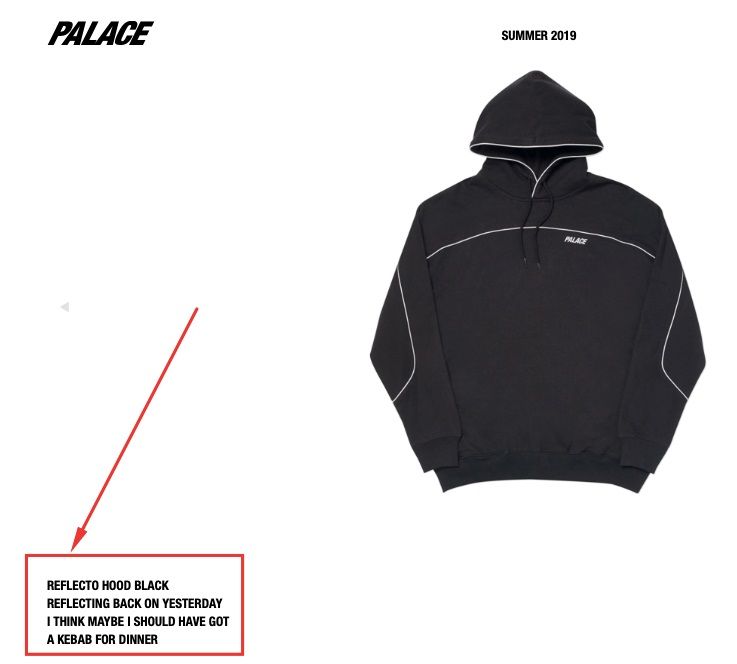![16 Simple Ways to Write Product Description That Sells [+ Examples]](https://www.webalive.com.au/wp-content/uploads/2019/09/How-to-write-product-description-725x412.jpg)
16 Simple Ways to Write Product Description That Sells [+ Examples]
How to create great product descriptions that sell?
No, it’s not just rattling on without taking a pause and coming to a stop about your products or services.
And no, excellent product descriptions have nothing to do with extensive paragraphs jam-packed with product details. Hardly anyone will ever read long-winded memoirs if they bore the reader to death from the very first line.
And, of course, it’s not solely about keywords, links, and all that mind-blowing SEO stuff that is supposed to help get better search positions in Google.
You’ll be surprised, but robust product descriptions are all about sharing your passion & explaining the value to your target customers.
Steve Jobs, the inventor of the well-loved Apple gadgets, believed that ‘people with passion can change the world for the better’.
Richard Branson, the founder of the Virgin and just an eccentric billionaire, too, is sure that ‘passion, like a smile, is contagious’.
Passion, like a smile, is contagious. It rubs off on everyone around you & attracts enthusiasts into your orbit https://t.co/8og9PixDmi pic.twitter.com/0ZyyKo3V4K
— Richard Branson (@richardbranson) October 21, 2016
Can you say that you are passionate about the products you sell online?
If not, you are doomed to drown in a sea of stronger competitors earlier than you launch your ecommerce business.
In this article, we’ll answer all the most important questions you need to address when creating product descriptions for your online store and give step-by-step information that will have you enjoying a piece of that appetizing ecommerce pie.
What is a product description?
As the name itself suggests, a product description is a form of marketing copy that explains what the product is, its benefit, its features and its usage. A great product description provides compelling reasons and eventually holds power to convince and convert a new buyer. In ecommerce, it is primarily put as a blurb of text on product pages providing needed context about the product you are selling and pushing customers to buy.
Stats that prove the importance of product content for ecommerce
Before digging into the aspects of creating high-quality product descriptions, let’s first take a helicopter view of the whole state of things in general.
Judging by Episerver’s “Reimagining Commerce” report, a whopping 98% of customers are deterred from making a purchase, because they lack information about the product or it is incorrect.
Just think of that! Only 2% of online shoppers do not give a toss about product features and benefits before buying them online.
Another argument in favour of creating proper product descriptions is the fact that, according to Salsify’s “Cracking the Consumer Code” research, 87% of shoppers find product content extremely valuable and prefer to read a little bit about the product before they decide to finally buy it.
The same study proved that half of online shoppers return the item they buy because it doesn’t match the product description.
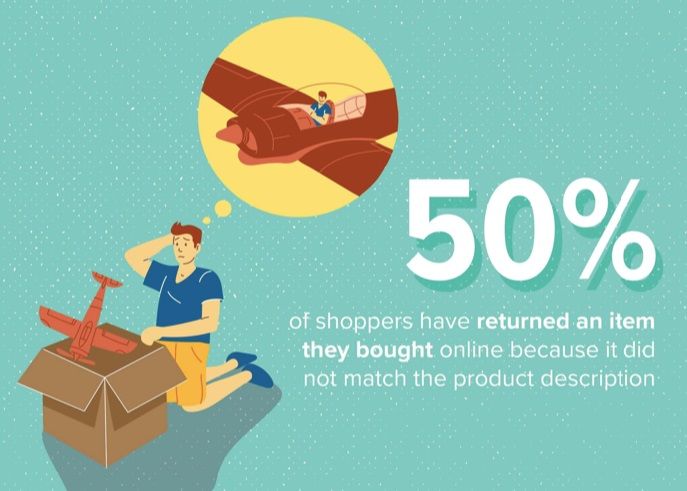
What do all these facts mean for you as a merchant?
In addition to its countless SEO benefits, thorough item descriptions play a vital role in the purchasing decisions of today’s consumers and, done right, can massively increase your sales.
So if your product descriptions lack accuracy (to say nothing of the products without any description at all!), do not be mocked with false hopes that your business will become in any way successful online.
And if a crappy product description can turn your potential customers away from the sale, the lack of one will make matters even worse.
To sum up, I dare say that content is one of the best investments today’s online merchants can make.
Following are some of the best strategies and approaches you can implement right away.
1. Highlight the benefits of your products
The time when shoppers were fully satisfied with one-size-fits-all descriptions is long gone.
Now people are no longer interested in earth-bound features and specifications. They are eager to find out what’s in it for THEM personally and how it will solve their troubles and save them from the biggest regrets.
The first lesson for you, no matter how shopworn it may sound to you, — is do not sell products, sell an experience.
Take a look at Method, San-Francisco based company manufacturing biodegradable natural cleaning supplies.
It feels like they know their target audience inside out and cares about their feelings.

Being a Method’s customer, I wouldn’t worry about my wardrobe even if I accidentally got a stain on my fav skirt.
They promise that my whites will stay white and the colours stay bright. And I can well believe it.
2. Use humour
Do not be afraid to perfect your joke-telling skills when writing descriptions for the products or services you sell online.
Just don’t over-indulge — too much of a good thing is good for nothing.
Humorous materials have been widely used in advertising for a good reason. According to the International Journal of Humor Research, they tend to be recalled at higher rates than non-humorous ones.
And here I cannot but name-check Palace, a London-based skateboard shop and clothing brand, with the funniest (… and the weirdest!) product descriptions I’ve ever stumbled upon on the web.
Their minimalistic design leaves their copywriters with no other option than to be creative.
Have a look at this multicolour windbreaker for, to put it correctly, big-boned guys from Palace.
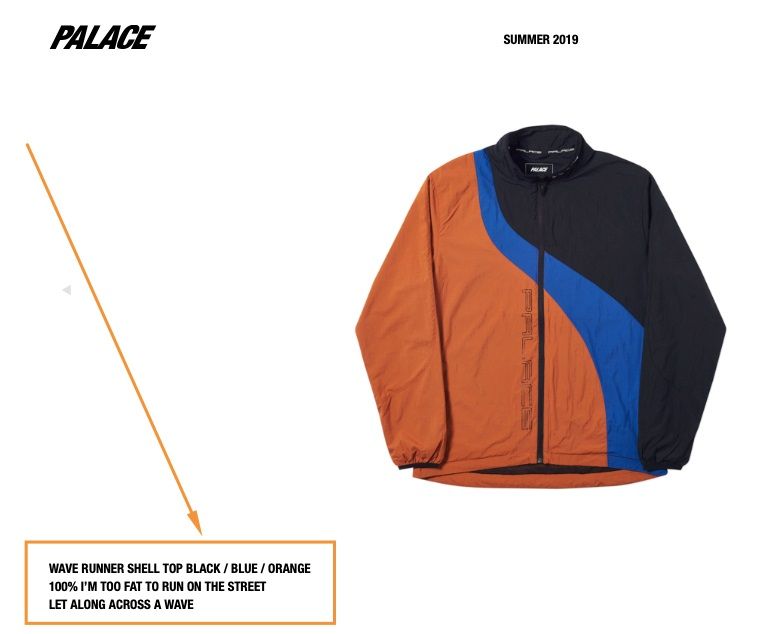
What about these kebab-related reflections of yesterday?
3. Keep SEO in mind
Hilarious product descriptions are good when you reckon upon word of mouth as the key advertising channel.
However, if you are looking to acquire new customers from Google, random copy written with a good sense of humour but without any logic and common sense (like that of Palace) won’t work, sorry.
What I mean here is that search engine optimization should not be an afterthought.
Let’s take CarID, a well-known automotive online store built with X-Cart ecommerce software.
If we analyze a random page (this one about custom wheels and rims, for instance) using SEMRush or any traffic analytics tool, we’ll see that their website is performing quite well in terms of SEO.

There are over 3.6K different keywords that bring users to their domain via Google’s top 100 organic search results. And the number is growing, which promises the good potential for the owners.
4. Define your buyer personas
Forget about crowds of unidentified buyers — each and every client of yours is a unique personality with their own interests, worries, and hopes for a bright future.
Try to understand what your audience is craving. Or just follow the example of Soap & Glory — a fun, fresh, fearless, and fantastic British beauty brand from Nottingham, England.
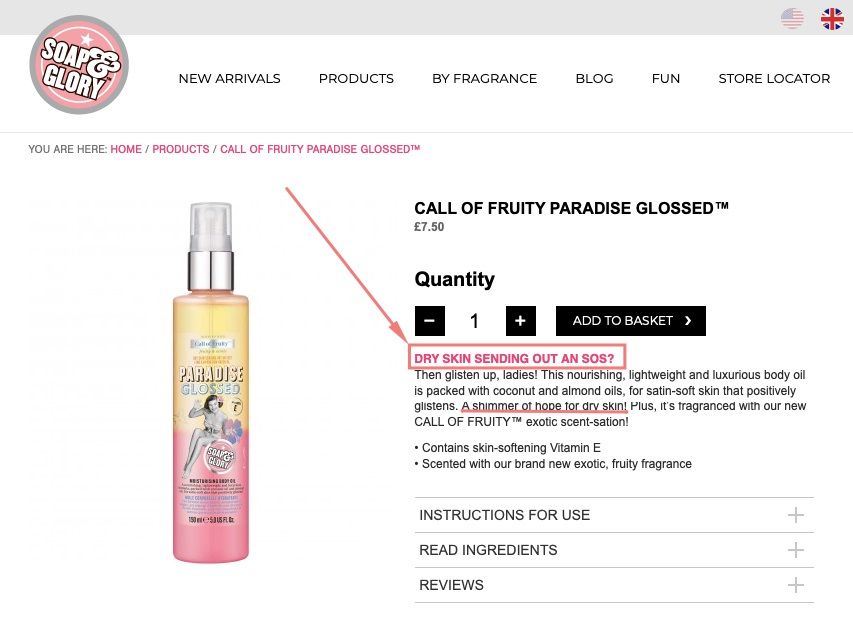
‘Cards Against Humanity’ also keep their ideal buyer in mind — a horrible person, with despicable and awkward friends.

Hah, they know exactly who they are selling to, for sure!
5. Keep things simple
The easier your product descriptions are, the more transparent your brand may seem to your target audience.
Speak the language your customers use in everyday life. Do not try to be too smart. Relax and let your copy sound lighthearted.
Take, for instance, the much-loved Dollar Shave Club.

They do not try to confuse their users with lofty phrases. Everything is quite simple — short paragraphs ordered lists. They address the reader as ‘you’, thus making the relationship a bit more personal.
6. Be honest
Do the products you sell have any drawbacks?
I’m sure that there is at least one thing that you conceal from your customers. Don’t.
Your shoppers will appreciate your willingness, to be frank about your brand. They’ll see that your copy is not just a marketing ad, but an accurate description that depicts your product from various angles.
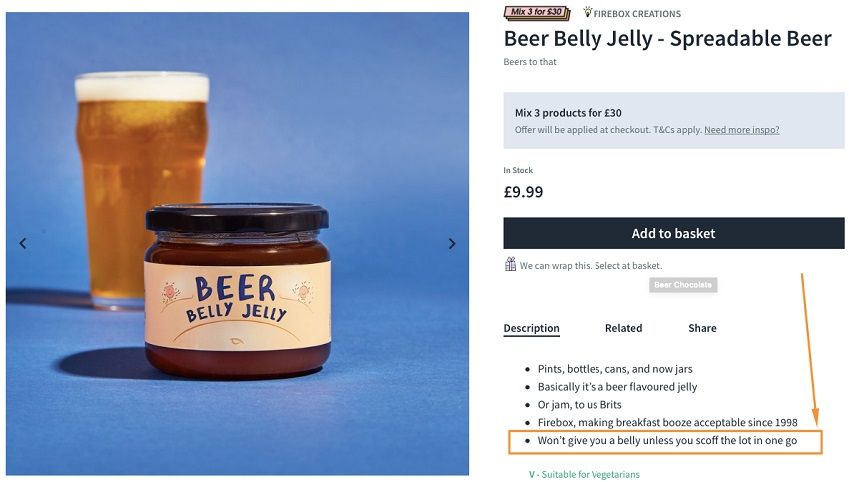
Take a look at FIREBOX. They claim to sell unusual gifts for people with imagination, and they really do.
For example, Beer Belly Jelly spreadable beer, “won’t give you a belly unless you scoff the lot in one go.”
7. Make your copy easily scannable
If you are able to encapsulate your ideas in a few short paragraphs, you can be proudly named a pro copywriter.
Innocent Drinks, selling more than two million smoothies per week, know how to market its products right.

Only the main points are highlighted. Or what else could be said about apple & mango juice other than that these fruits are delicious? They are, indeed.
8. Explain how your customers may use your product
Providing customers with clear instructions on how to use your products is vital. This, again, means that you care about people.

This Etsy seller knew that hung inside, out of direct sunlight, this Blue and White Dried Flower Wreath will last for years.
And this may turn your first-time shoppers into loyal standing customers.
9. Tell your story
There’s nothing more engaging than stories. You can try and use this trick in your copy. And I’m sure there’s a lot to share. Introduce your shoppers to the history of your brand.
Tell what inspired you to create this product and fancy how your product can be valuable to the buyer.

This Sass & Belle keep growing planter is not just a run-of-the-mill pot that can be easily found on any Chinese website like Alibaba. There is a whole history behind this brand.
10. Appeal to emotions
This is one of the most common tricks that marketing professionals use to persuade people to buy a product, subscribe to monthly services or updates, or just be more impressive.
An emotional appeal works best when you use images that evoke emotions like joy, and sadness, to name but a few.

That’s what FIREBOX (yeah, here they go again!) does. Just look up at that melancholy Stuffed Blobfish face. It will never leave you unfazed.
The same goes for the other Firebox products — you’ll either blubber like a whale or laugh out loud, but you’ll never be left indifferent.
They took a step further and created product descriptions that speak directly to a targeted emotion.
11. Embrace your eccentric side
Eccentricity is one of the effective ways that brands can use to make their products or services stand out.
Kallø, a Dutch company focused on organic foods, has become famous for its sometimes bizarre and geeky self-written poems.
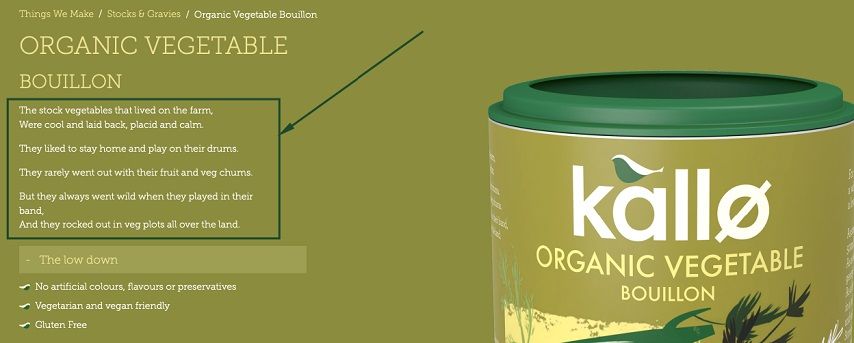
Just think of that — this is a poem about organic vegetable bouillon! No one has ever made rhymes about stock vegetables that ‘lived on the farm’ and ‘rarely went out with their fruit and veg chums’.
If you also want your brand to show up, surprise your website visitors with something extraordinary.
12. Keep to the point
To write an excellent product description that sells, you need to do much more than educate customers.
Not to bore the reader to death with sprawling sentences, it is critical to be succinct and to the point.. just like ThinkGeek.
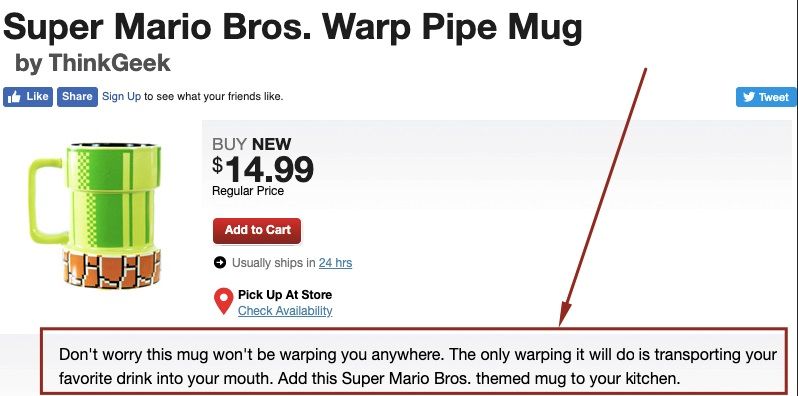
We can witness here that the product description for a mug does not have to be dry. ThinkGeek created an effective three-sentence reader-friendly product description, that will transport your mind back to the 90s when the Mario game was popular.
No, it won’t be warping you anywhere.
13. Create consistency in your tone
No matter how different your products are, it’s recommended to maintain the same level of consistency in your product descriptions across your ecommerce site.
Otherwise, users may be disappointed when they notice that your product pages do not live up to their expectations.
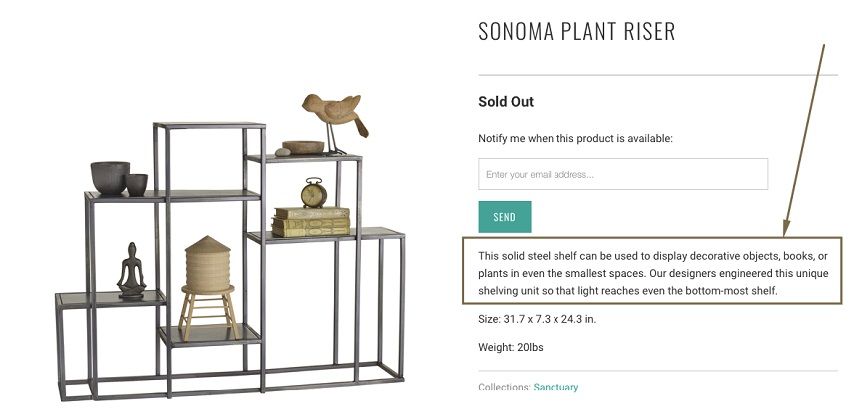

There’s nothing too extravagant or special about Fab’s product descriptions. However, all of them are of the same size and tone, and with the same buyer personas in mind.
14. Avoid generic phrases
No one likes such boring generic phrases as ‘excellent hand soap’ or ‘of the best quality’. That’s what everyone says. And that sounds highly unprofessional.
What is unique about your products?
Amazon, for example, knows why Kindle is the most advanced e-reader:

Tone down your expressiveness, use moderate words, or just explain the superlatives you use.
An ‘excellent hand soap’ can be replaced by something like a ‘soap for killing disease-causing germs’. And a backpack that is ‘of the best quality’ means that it ‘keeps your laptop dry even if you are caught by the rain’.
And if you’ve got nothing to say, just quote a happy customer who is madly in love with your products. This will add more credibility to your copy.
15. Use visuals
Simply put, today’s customers buy with their eyes. As contact remains limited when purchasing online, users tend to use their visual senses to make a purchase decision. By showing any image, videos, animation or graphics of the product, you can make it easy for potential customers to imagine having the product they are looking for.
So, when planning your ecommerce design, add visuals to turn your views into meaningful marketing results. And when you are doing it, make sure you are providing enough visual information because this ties in with reducing return rates, lesser inquiries, and a friendlier user experience.
Here, we can see how The Iconic incorporates several photos of a particular item by having a model wear them. to give customers a dynamic look at your product.

16. Add product reviews
Customers often look for suggestions about what to buy. After all, they need to be sure that you are a dependable brand to trust.
And here’s why you need to showcase reviews to write product descriptions that sell. Customer reviews work even far better than a sales pitch. When someone else says your product is great, your chances of getting more leads rise.
A customer’s feedback immediately eliminates a shopper’s concern regarding a product. It helps prospects with better insights and makes them understand what they can expect from a particular product, its pros, flaws and performance. No doubt, you will be losing out a considerable number of potential customers if you skip adding a product review section to your product description page.
Here, Asos exemplifies this point perfectly. It includes customer reviews on each product page and displays the rating system depending on size, comfort and quality.
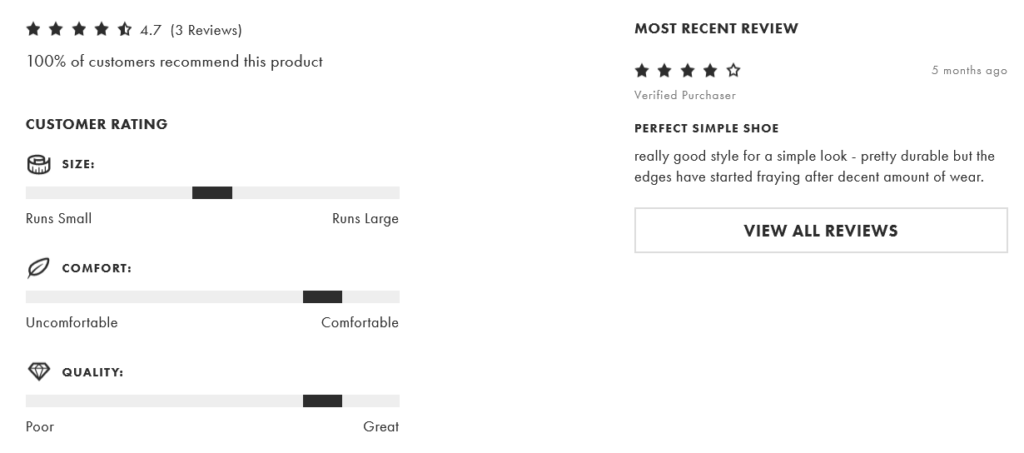
The Bottom Line
Now that you know a little bit about writing great product descriptions, it’s high time you got down to business and reviewed your website copy.
Mastering product copy will definitely require some time, testing and, what is more important, creativity. Don’t be afraid of experimenting with your copy, and maybe someday your product description will be used as an example in an article like this.
You read a lot. We like that
Want to take your online business to the next level? Get the tips and insights that matter.
